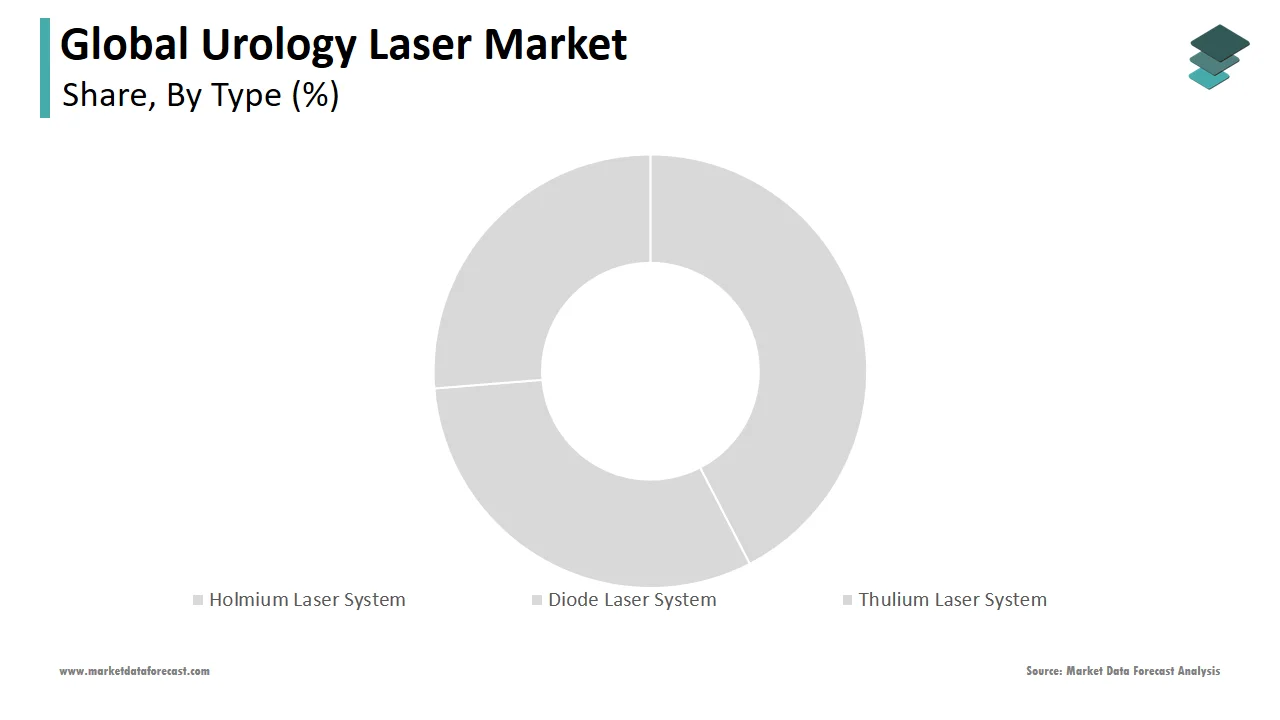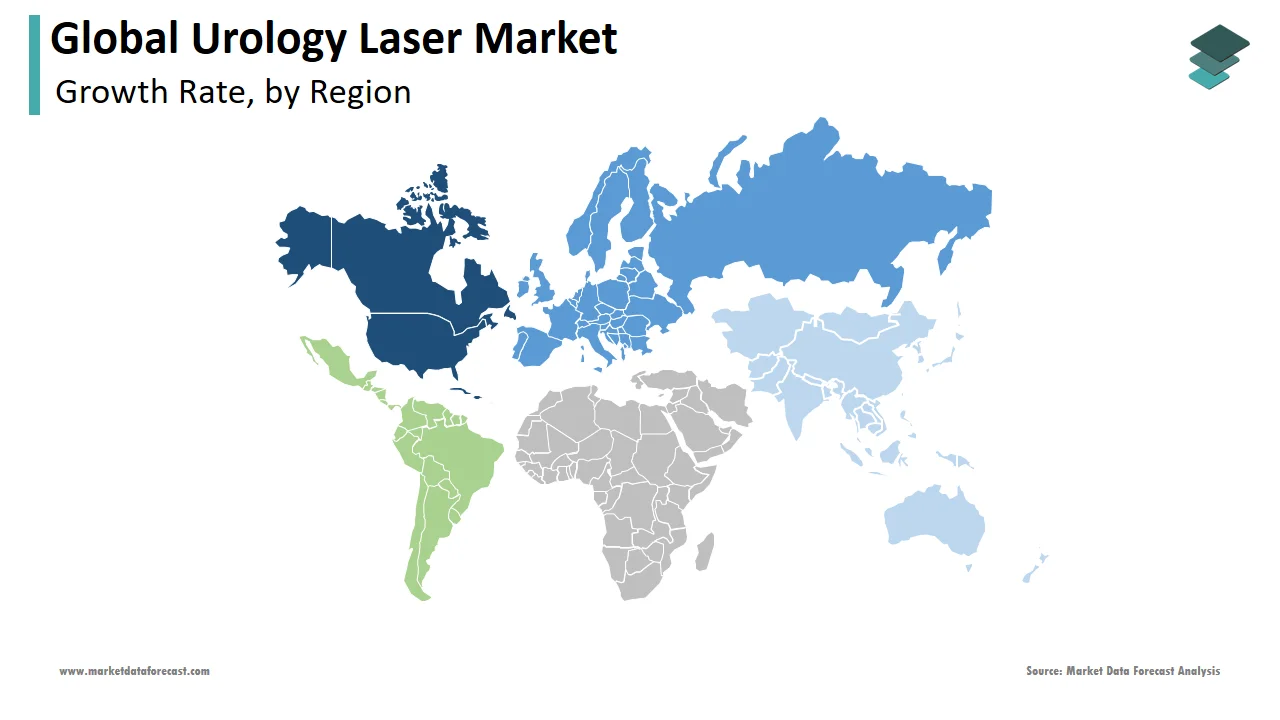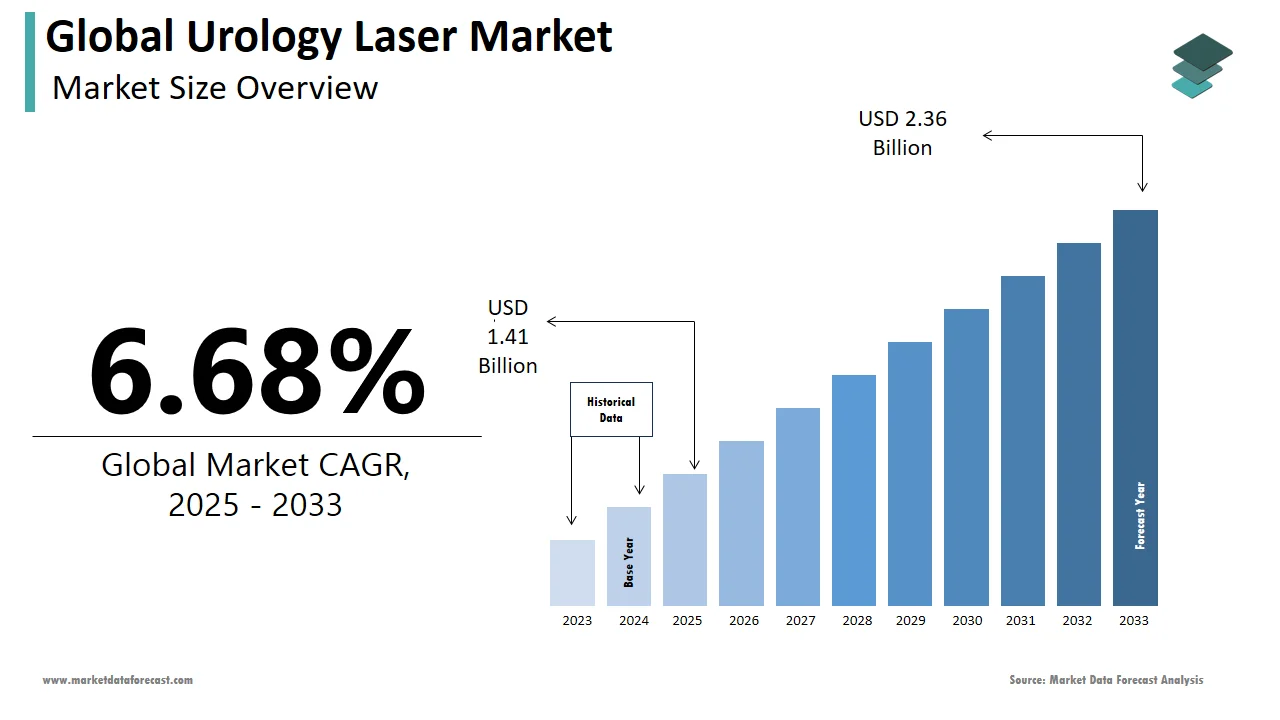Global Urology Laser Market Size, Share, Trends & Growth Forecast Report By Type, Application, End-User and Region (North America, Europe, Asia-Pacific, Latin America, Middle East and Africa), Industry Analysis From 2025 To 2033.
Global Urology Laser Market Size
The size of the global urology laser market was worth USD 1.32 billion in 2024. The global market is anticipated to grow at a CAGR of 6.68% from 2025 to 2033 and be worth USD 2.36 billion by 2033 from USD 1.41 billion in 2025.
MARKET DRIVERS
The growing prevalence of urological disorders, especially among women, and the increased incidence of chronic kidney disease are some of the factors driving the urology lasers market.
As per the American Urological Association, an estimated 1 in 11 individuals in the U.S. population suffer from kidney stones. In addition, increasing demand for minimally invasive surgical procedures, growing initiatives by public and private organizations, and increased federal government funding to improve healthcare propel the urology lasers market. Furthermore, the growth and expansion of the healthcare sector are also driven by influencing key market trends globally, focusing on developing new innovative products using cutting-edge techniques for better service to healthcare professionals and patients.
The growing geriatric population worldwide are predicted to augment the urology laser market growth.
Older adults are more susceptible to developing urological diseases among the growing senior population. Therefore, the rising prevalence of kidney diseases like kidney, urinary tract, and ureter stones, the rising incidence rate of urinary tract infections (UTIs), and prostate cancer are driving the growth in demand for surgical procedures, which in turn is driving the growth in demand for lasers for urology.
Moreover, the latest laser procedures provide many benefits of smaller incisions, less overall body pain, shorter hospital stays, faster recovery, and less blood loss, and features of security and reliability are expected to drive the market growth. In addition, these laser systems offer minimally invasive surgeries, with several advantages like rapid recovery, safety, and increased efficiency, which led to increased demand for holmium and thulium-based systems with benefits of good results with minimized treatment side effects and shorter hospital stays. Furthermore, faster recovery, rising awareness about various benefits of urology lasers, and increasing personal disposable income are some of the other significant factors that drive the growth of the urology laser market.
MARKET RESTRAINTS
Factors such as high costs associated with R&D, stringent regulatory requirements for medical approval, high cost of lasers, lack of awareness among people in underdeveloped economies, and limited infrastructure in many developing countries are hampering the growth of the urology laser market. Furthermore, a lack of awareness about the benefits of minimally invasive urology laser surgery, the high expenditure required for research activities, and the availability of alternative procedures for treating various UTIs are expected to hamper the market growth.
REPORT COVERAGE
|
REPORT METRIC |
DETAILS |
|
Market Size Available |
2024 to 2033 |
|
Base Year |
2024 |
|
Forecast Period |
2025 to 2033 |
|
CAGR |
6.68% |
|
Segments Covered |
By Type, Application, End-User, and Region. |
|
Various Analyses Covered |
Global, Regional, and country-level analysis; Segment-Level Analysis, DROC; PESTLE Analysis; Porter’s Five Forces Analysis, Competitive Landscape; Analyst Overview of Investment Opportunities |
|
Regions Covered |
North America, Europe, APAC, Latin America, Middle East & Africa |
|
Market Leaders Profiled |
Asclepion Laser Technologies GmbH, Boston Scientific Corporation, biolitec AG, Convergent Laser Technologies, Lumenis, Healthware Pvt. Ltd., EMS Urology, JenaSurgical GmbH, OmniGuide Holdings, Inc., Olympus Corporation, Richard Wolf GmbH, and Quanta System., and Others. |
SEGMENTAL ANALYSIS
By Type Insights

Based on type, the holmium laser system segment dominated the urology laser market in 2022 owing to the high usage in prostate surgeries requiring minimally invasive surgical techniques for the undisturbed urine flow through the prostate. Also, the demand for holmium systems is increasing amongst patients due to their safety and effectiveness in treating diseases, which is a less invasive procedure.
On the other hand, the thulium laser system segment is expected to grow at the fastest CAGR in the global urology laser market during the forecast period, a significant area of study to improve the effectiveness and durability of urethral stricture therapies utilizing safe, minimally invasive techniques. Thulium is used to efficiently treat these fibrotic strictures of the urethra brought on by spongiofibrosis brought on by various factors such as inflammation or trauma.
By Application Insights
Based on the application, the benign prostatic hyperplasia (BPH) segment is anticipated to lead the market due to the growing aging population. In addition, more men reaching puberty is increasing the prevalence of BPH, non-cancerous growth of the prostate due to uncontrolled expansion of prostate cells due to high testosterone levels, androgen receptor expression, and 5-alpha-reductase activity prevalent in African men, which occurs either during puberty or around the age of 25. Hence, there is an increase in urology laser treatment demand, significantly accelerating the segment's growth.
The urolithiasis segment is anticipated to gain momentum during the forecast period owing to the increasing number of patients suffering from bladder and urinary tract stones due to inadequate sanitary and unhealthy lifestyles. The primary cause of urolithiasis is the high intake of caffeine, which is linked to increased excretion of stone-forming compounds, like urate, calcium, oxalate, xanthine, phosphate, and cysteine, which in turn drives the demand for urology lasers for effective treatment.
By End-User Insights
Based on the end-user, the hospital segment is anticipated to represent much of the urology laser market share owing to the improved treatment using advanced solutions provided by the hospitals, high-profit margins, and purchasing products at lower prices.
The specialized clinics segment is anticipated to grow at a promising CAGR during the forecast period. The specialized centers for urology help in personalized and quick treatment of disorders related to urology at a low cost, which leads to more patients' preference for such centers, which in turn is the reason for the high growth of specialized clinics in this segment.
REGIONAL ANALYSIS

Based on region, North America led the market, accounting for a promising share of the global market during the forecast period owing to the increasing prevalence of urological disorders such as bladder cancer, growing preference for minimally invasive procedures for the benefits of less operative time and fewer complications, increasing prevalence of urolithiasis, BPH, and other urology-related disorders, and the rise in population, among which older people are often susceptible to urological diseases, like urinary incontinence. In addition, 50% of the patients in the U.S. suffer from urolithiasis due to calcium and fluid intake, leading to the formation of urinary stones, according to the NCBI. Therefore, the adoption and emergence of novel technologies, the availability of well-established companies in the U.S. engaged in developing new products, rising healthcare expenditure, and technological advancements in urology laser equipment are helping the urology market grow.
Europe is expected to be the second most productive market of urology lasers in this region owing to factors such as growing health-related issues, the implementation of innovative medical technologies, the increasing geriatric population, increasing awareness of physical health, increasing prevalence of kidney disease, and launching of innovative lasers to treat increasing incidence of urological diseases.
However, Asia-Pacific is presumed to have the highest market growth potential, which is attributed to an increase in the frequency of patients with urological disorders like bladder stones, benign prostatic hyperplasia, and urinary stones, an increasing elderly population, an increase in medical tourism, an increase in cases of urological disorders like urolithiasis, bladder cancer, urinary stones, and prostate diseases, and increase in government awareness initiatives.
Other significant factors include the growing demand for quality health care in East and Southeast Asia, which are expected to show the highest growth rate across the Asia-Pacific region. In addition, the prevalence of urological disorders is from 5% to 19.1%, according to the National Center for Biotechnology Information (NCBI), in West, South, and Southeast Asia, including other developing countries like South Korea and Japan. Therefore, the number of people suffering from urolithiasis, like urology disorders, is increasing, which drives the urology laser market growth.
The regions of Latin America, the Middle East, and Africa are presumed to grow reasonably over the forecast period owing to growing technological advancements and a rise in awareness of urological laser benefits among the various developing economies in the region.
KEY MARKET PARTICIPANTS
Companies playing a promising role in the global urology laser market profiled in this report are Asclepion Laser Technologies GmbH, Boston Scientific Corporation, biolitec AG, Convergent Laser Technologies, Lumenis, Healthware Pvt. Ltd., EMS Urology, JenaSurgical GmbH, OmniGuide Holdings, Inc., Olympus Corporation, Richard Wolf GmbH, and Quanta System.
RECENT HAPPENINGS IN THIS MARKET
- In September 2022, the Bladder Cancer Company, Photocure ASA, announced the first results of the Laser III clinical study, which demonstrates non-inferiority in outpatient laser bladder, to verify the safe treatment of bladder tumors in the outpatient setting.
- In September 2022, UroGen, a biotechnology company called, which is committed to creating and marketing cutting-edge treatments for the treatment of urothelial and specialized malignancies, reported that the FDA had put a 96-hour reconstitution of its product which affects hospitals, doctors, pharmacists, and adult patients for treatment of low-grade upper tract urothelial carcinoma.
MARKET SEGMENTATION
This global urology laser market research report is segmented and sub-segmented into the following categories.
By Type
- Holmium Laser System
- Diode Laser System
- Thulium Laser System
By Application
- Benign Prostatic Hyperplasia (BPH)
- Urolithiasis
- Non-Muscle-Invasive Bladder Cancer (NMIBC)
By End-User
- Hospitals
- Specialized Clinics/Centers
By Region
- North America
- Europe
- Asia Pacific
- Latin America
- Middle East and Africa
Frequently Asked Questions
1. How much is the global urology laser market going to be worth by 2033?
Asclepion Laser Technologies GmbH, Boston Scientific Corporation, biolitec AG, Convergent Laser Technologies, Lumenis, Healthware Pvt. Ltd., EMS Urology, JenaSurgical GmbH, OmniGuide Holdings, Inc., Olympus Corporation, Richard Wolf GmbH, and Quanta System are some of the companies playing a key role in the global urology laser market.
2. Which are the major players operating in the urology laser market?
Geographically, the North American regional market dominated the urology laser market in 2024.
Related Reports
Access the study in MULTIPLE FORMATS
Purchase options starting from
$ 2500
Didn’t find what you’re looking for?
TALK TO OUR ANALYST TEAM
Need something within your budget?
NO WORRIES! WE GOT YOU COVERED!
Call us on: +1 888 702 9696 (U.S Toll Free)
Write to us: sales@marketdataforecast.com

